
This is a list of tourist attractions in Wales, sorting attractions by settlement, protected area and popularity from across the country of Wales, United Kingdom.

This is a list of tourist attractions in Wales, sorting attractions by settlement, protected area and popularity from across the country of Wales, United Kingdom.
The following list are of attractions in notable settlements in Wales.

At present, Wales has three national parks: Snowdonia, Pembrokeshire Coast and the Brecon Beacons National Park, as well as five areas of outstanding natural beauty (AONB), which together form the Protected areas of Wales. [18]
| Name | Photo | Principal area(s) | Date formed [19] | Area |
|---|---|---|---|---|
| Snowdonia (Eryri) |  | Gwynedd, Conwy | 18 October 1951 | 2,142 square kilometres (827.0 sq mi) |
| Pembrokeshire Coast (Arfordir Penfro) |  | Pembrokeshire | 29 February 1952 | 620 square kilometres (239.4 sq mi) |
| Brecon Beacons (Bannau Brycheiniog) | | Blaenau Gwent, Carmarthenshire, Merthyr Tydfil, Powys, Rhondda Cynon Taf, Monmouthshire, Torfaen, Caerphilly | 17 April 1957 | 1,351 square kilometres (521.6 sq mi) |
Many features of the Welsh landscape that are popular with visitors, include:

There are several notable independent attractions:


The following are the most popular paid attractions in Wales (2019) in order of the number of visits:

The Association of Leading Visitor Attractions (ALVA) report for 2023 lists the following eight free-admission Welsh attractions in order of the number of visits (the first figure is visitor numbers the second, the attraction's UK ranking): [33]
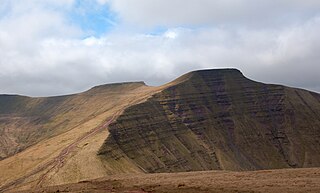
The Brecon Beacons are a mountain range in Wales. The range includes South Wales's highest mountain, Pen y Fan, its twin summit Corn Du, and Craig Gwaun Taf, which are the three highest peaks in the range. The Brecon Beacons have given their name to the larger Brecon Beacons National Park, and the range itself is therefore sometimes known as the Central Beacons to differentiate the two.

Powys is a county and preserved county in Wales. It borders Gwynedd, Denbighshire, and Wrexham to the north; the English ceremonial counties of Shropshire and Herefordshire to the east; Monmouthshire, Blaenau Gwent, Merthyr Tydfil, Caerphilly, Rhondda Cynon Taf, and Neath Port Talbot to the south; and Carmarthenshire and Ceredigion to the west. The largest settlement is Newtown, and the administrative centre is Llandrindod Wells.

Merthyr Tydfil is the main town in Merthyr Tydfil County Borough, Wales, administered by Merthyr Tydfil County Borough Council. It is about 23 miles (37 km) north of Cardiff. Often called just Merthyr, it is said to be named after Tydfil, daughter of King Brychan of Brycheiniog, who according to legend was slain at Merthyr by pagans about 480 CE. Merthyr generally means "martyr" in modern Welsh, but here closer to the Latin martyrium: a place of worship built over a martyr's relics. Similar place names in south Wales are Merthyr Cynog, Merthyr Dyfan and Merthyr Mawr.
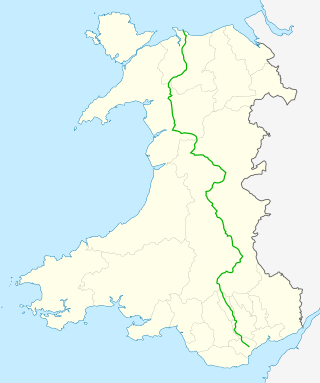
The A470 is a trunk road in Wales. It is the country's longest road at 186 miles (299 km) and links the capital Cardiff on the south coast to Llandudno on the north coast. While previously one had to navigate the narrow roads of Llanidloes and Dolgellau, both these market towns are now bypassed due to extensive road modernisation. The 26 miles (42 km) from Cardiff Bay to Merthyr Tydfil are mainly dual carriageway, but most of the route from north of Merthyr to Llandudno is single carriageway.

Brecon Beacons National Park, officially named Bannau Brycheiniog National Park, is a national park in Wales. It is named after the Brecon Beacons, the mountain range at its centre. The national park includes the highest mountain in South Wales, Pen y Fan, which has an elevation of 886 metres (2,907 ft).

South Wales is a loosely defined region of Wales bordered by England to the east and mid Wales to the north. Generally considered to include the historic counties of Glamorgan and Monmouthshire, south Wales extends westwards to include Carmarthenshire and Pembrokeshire. In the western extent, from Swansea westwards, local people would probably recognise that they lived in both south Wales and west Wales. The Brecon Beacons National Park covers about a third of south Wales, containing Pen y Fan, the highest British mountain south of Cadair Idris in Snowdonia.
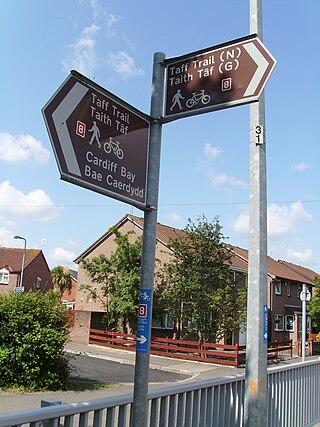
The Taff Trail is a walking and cycle path that runs for 55 miles (89 km) between Cardiff Bay and Brecon in Wales. It is so named because it follows the course of the River Taff. Along much of its length, it follows the National Cycle Network Route 8 that continues to Holyhead, and is substantially off-road.

Pen y Fan is the highest peak in South Wales, situated in Brecon Beacons National Park. At 886 metres (2,907 ft) above sea-level, it is also the highest British peak south of Cadair Idris in Snowdonia. It is the highest point of the historic county of Brecknockshire. The twin summits of Pen y Fan and Corn Du at 873 metres (2,864 ft) were formerly referred to as Cadair Arthur or 'Arthur's Seat'.
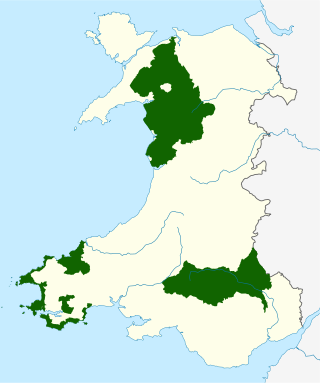
The national parks of Wales are managed areas of outstanding landscape in Wales, United Kingdom where some forms of development are restricted to preserve the landscape and natural environment. Together, they cover 20% of the land surface of Wales and have a resident population of over 80,000 people. Each National Park Authority is a free-standing body within the local government framework.
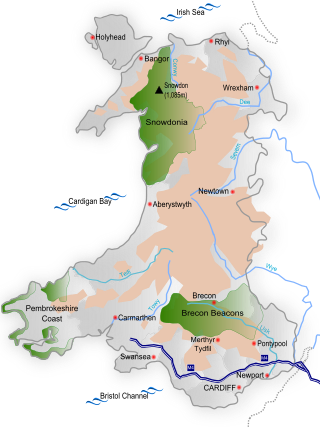
Wales is a country that is part of the United Kingdom and whose physical geography is characterised by a varied coastline and a largely upland interior. It is bordered by England to its east, the Irish Sea to its north and west, and the Bristol Channel to its south. It has a total area of 2,064,100 hectares and is about 170 mi (274 km) from north to south and at least 60 mi (97 km) wide. It comprises 8.35 percent of the land of the United Kingdom. It has a number of offshore islands, by far the largest of which is Anglesey. The mainland coastline, including Anglesey, is about 1,680 mi (2,704 km) in length. As of 2014, Wales had a population of about 3,092,000; Cardiff is the capital and largest city and is situated in the urbanised area of South East Wales.

Transport in Wales is heavily influenced by the country's geography. Wales is predominantly hilly or mountainous, and the main settlements lie on the coasts of north and south Wales, while mid Wales and west Wales are lightly populated. The main transport corridors are east–west routes, many continuing eastwards into England.

The National Eisteddfod of Wales is the largest of several eisteddfodau that are held annually, mostly in Wales. Its eight days of competitions and performances are considered the largest music and poetry festival in Europe. Competitors typically number 6,000 or more, and overall attendance generally exceeds 100,000 visitors, the highest recently being 118,000 attending the 2022 festival. The 2018 Eisteddfod was held in Cardiff Bay with a fence-free 'Maes'. In 2020, the event was held virtually under the name AmGen; events were held over a one-week period.

Tourism in Wales makes up a significant portion of the Welsh economy and attracting millions of visitors each year. The tourism industry in Wales was worth around £5bn in 2017. The tourism industry also makes a significant contribution to the Welsh economy, supporting over 100,000 jobs and more than 8% of the Welsh workforce. Wales attracts visitors from overseas, particularly from the United States, Australia, Germany and the Republic of Ireland.
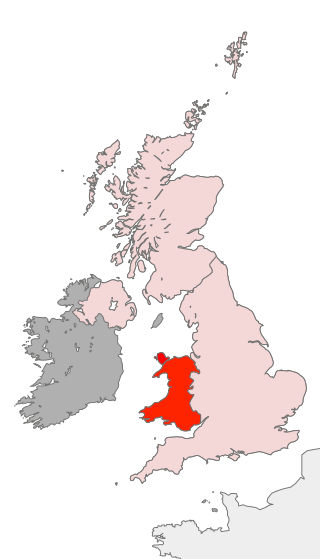
Scouting in Wales provides an overview of Scouting activities in Wales. Scout troops have existed in the country since 1908 with the largest number of Scouts and volunteer leaders today linked to the Scout Association of the United Kingdom. This is done through ScoutsCymru, the Welsh Scout Council who split the region further into four regions and a total of 12 Scout Areas. In addition to the Scout Association, there are also traditional Scouting groups belonging to the Baden-Powell Scouts' Association and a number of Scouting clubs within Universities which are affiliated to the Student Scout and Guide Organisation.

Golf is a popular sport in Wales. Although the sport of golf in Great Britain is most associated with Scotland, where it was established and developed, Wales can record its first courses back to the 1880s, and today has over 200 clubs. The first amateur golf competition was held in 1895, and the first professional championship was in 1904. Wales has produced several players of note, including one player, Ian Woosnam, who has won one of the Men's major golf championships and Wales has twice won the men's World Cup, in 1987 and 2005, respectively. Wales also hosted the Ryder Cup, when it was held at Newport's Celtic Manor Resort in 2010.

The natural resources of Wales have contributed substantially to the economic wealth of the United Kingdom from pre-Roman times to the present. Wales has a complex and varied geology with a wealth of natural minerals. Although Wales has been strongly associated with the coal industry, it has also been the world's leading supplier of slate and of copper at different times. The country lies along the western side of Great Britain and is buffeted by the prevailing South-Westerly trade winds which bring year round rain and wind but also maintain an equable temperate climate. The combination of climate and physical geography and geology have given rise to many different types of landscape and biomes rich in species variety.
The Wales Way is the name collectively given to a series of three tourist routes in Wales, UK, promoted by Visit Wales, the government agency charged with promoting tourism in the country. The three routes are the 180-mile Coastal Way, the 75-mile North Wales Way and the 185-mile Cambrian Way. The Wales Way was launched in late 2018.